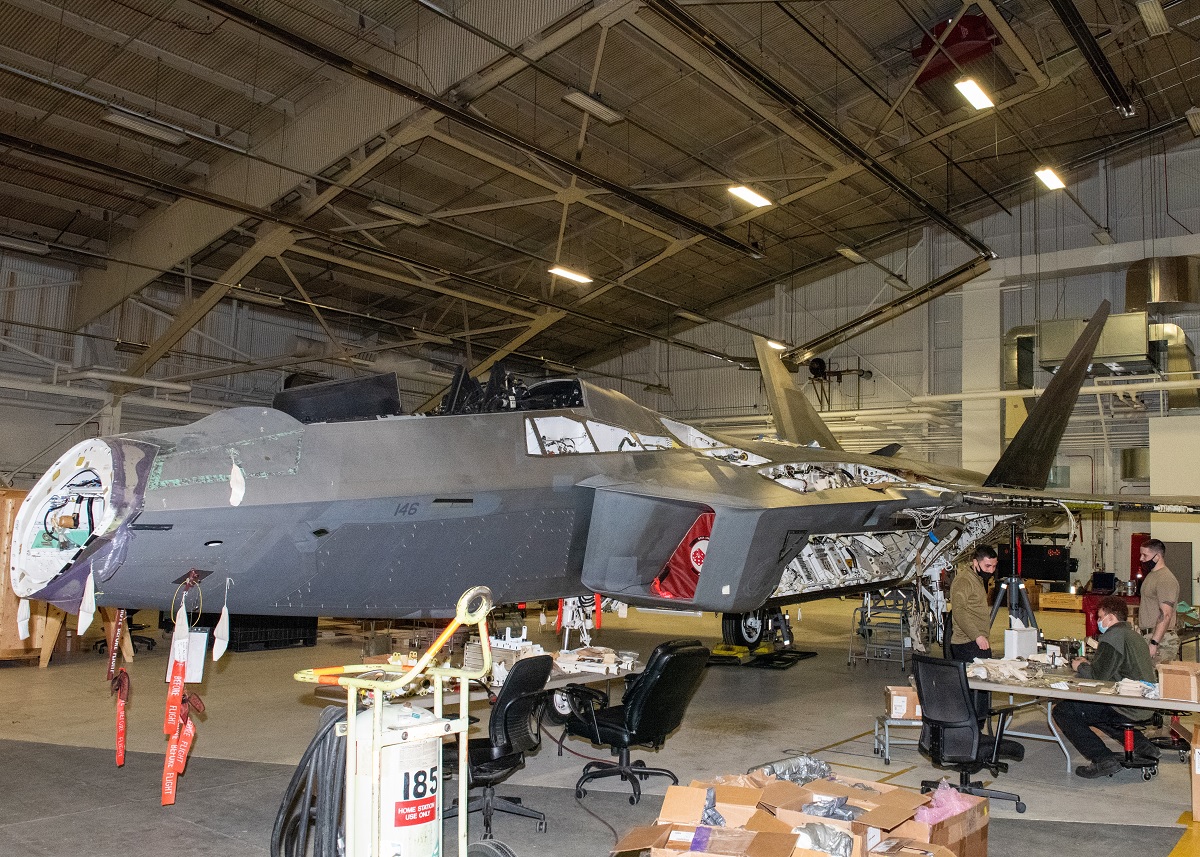With steady progress being made on the rebuild, the functional check flight for F-22 Raptor tail number AF-07-146 is now projected for March 2022.
Aircraft crew chiefs are typically responsible for daily maintenance, aircraft care, and inspections to ensure their aircraft are mission ready. However, two crew chiefs at Joint Base Elmendorf-Richardson became part of a unique team tasked with rebuilding an F-22 Raptor.
US Air Force Tech. Sgt. Kevin Fitch and Staff Sgt. Ethan Rentz, 3rd Aircraft Maintenance Unit F-22 crew chiefs, are nearing the end of a years-long process that began shortly after tail number AF-07-146 skidded to a stop on its belly immediately after takeoff at Naval Air Station Fallon, Nevada, in April 2018.

Fortunately, the pilot was unharmed even though the aircraft sustained substantial damage. Since the aircraft belongs to the 3rd Wing, a team from JBER went down to dismantle the jet, load it into a cargo aircraft and transport it home.
Rentz was among the group that disassembled the F-22 in Nevada and prepared it for transport.
“We had to fit it into a C-5 [Galaxy aircraft], so we took off everything that was damaged and everything that wouldn’t fit dimensionally,” Rentz said in the article Crew chiefs rebuild F-22 after the fiery crash by Senior Airman Samuel Colvin, JBER Public Affairs. “We removed the wings and vertical stabilizers, and the whole belly of the F-22 because those panels were damaged and burnt. We couldn’t have those panels flapping around or breaking off during transit.”

The disassembly took about a month. Then the jet was transported to JBER for a thorough analysis to evaluate whether or not the aircraft should be restored.
“Everything worked out in the simulations, so the aircraft was put in our hangar in January 2020 and put on stands,” Fitch said. “That’s when the complete strip started — the wire harnesses, the struts, and the bulkhead. It was down to the bones of the fuselage at that point.
“Contractors, engineers, and structures personnel spent about 16 months replacing almost the whole bottom of the aircraft, the fuselage stations, and more than 40 wire harnesses,” Fitch continued. “Our active-duty guys didn’t start having a hand in the rebuild until June this year.”

Fitch created inventory lists and order-tracking spreadsheets to keep the myriad of parts needed for the aircraft rebuild organized.
“Sergeant Fitch picked this up from nothing,” Rentz said. “He’s operating at a master or senior master sergeant level because he’s not just handling crew chief tasks, he’s coordinating with multiple different backstops and agencies. He’s essentially running a one-man aircraft squadron.”
As the ordered parts arrive, Rentz and Fitch sort, continue to label, and organize them to ensure the rebuild goes smoothly.

“Right now the biggest challenge is acquiring parts because the F-22 isn’t manufactured anymore,” Fitch said. “Some of the parts won’t be available until summer or fall of 2022, so we’ll probably end up canning those from aircraft that are going to be down for a while.”
Canning, short for cannibalizing, is a term that refers to taking usable parts from one aircraft for use on another, depending on various aircraft’s state of repair and the timeline for newly manufactured parts to be completed. This method returns aircraft to combat-capable status sooner because it cuts down on the time waiting for new parts to be manufactured.
With parts arriving throughout the year, Rentz compared rebuilding the F-22 to completing a puzzle. Though they have some parts to complete sections of the aircraft, the intent is not to undo those repairs when other parts arrive to complete repairs that are necessary behind the previously built section.

With steady progress being made on the rebuild, the functional check flight for tail number AF-07-146 is now projected for March 2022. If the timeline doesn’t get delayed, both Rentz and Fitch will be here to see the jet fly once again.
As previously reported, on the day of the accident F-22 AF-07-146’s pilot took off from Fallon for a Topgun graduation exercise. The pilot rotated the aircraft — bringing the nose up — at 120 knots and as the aircraft indicated its wheels were leaving the ground, the pilot retracted the landing gear. Immediately after the landing gear retracted, the aircraft “settled” back on the runway with the doors fully closed.
With its tailhook bouncing off the ground, the F-22 slid about 6,514 feet until coming to a rest. Once it came to a stop, the pilot egressed the cockpit and there was no damage to other property.
The Accident Investigation Board found that the pilot had incorrect Takeoff and Landing Data for the conditions at Fallon — the pilot’s lineup card stated 136 knots indicated airspeed knots for rotation and 163 knots for full takeoff while that day’s conditions called for 143 knots for rotation and 164 knots for takeoff.
The investigation also found that the pilot prematurely retracted the landing gear and that day’s flight brief was inadequate.
Since F-22s are no longer manufactured, returning this jet to mission-capable and combat-ready status is important for not only the 3rd Wing capabilities but the capabilities of the entire USAF.
Photo by U.S. Air Force photo by Senior Airman Samuel Colvin

